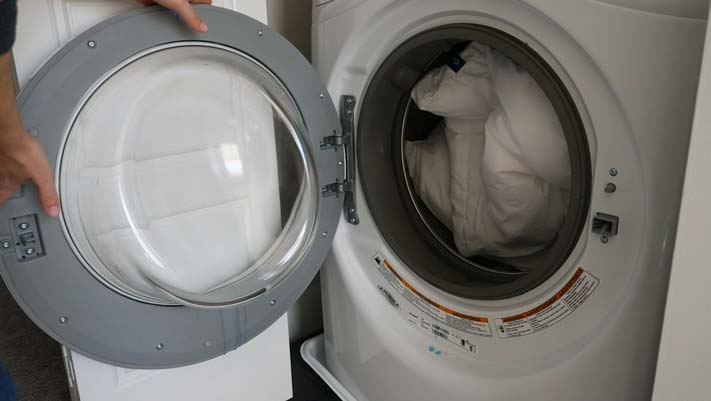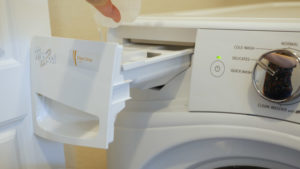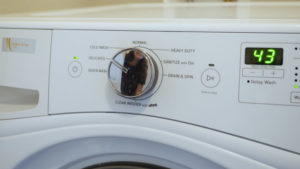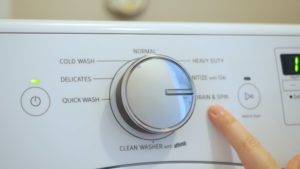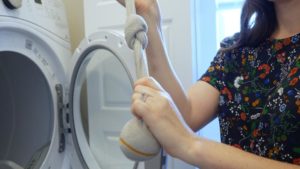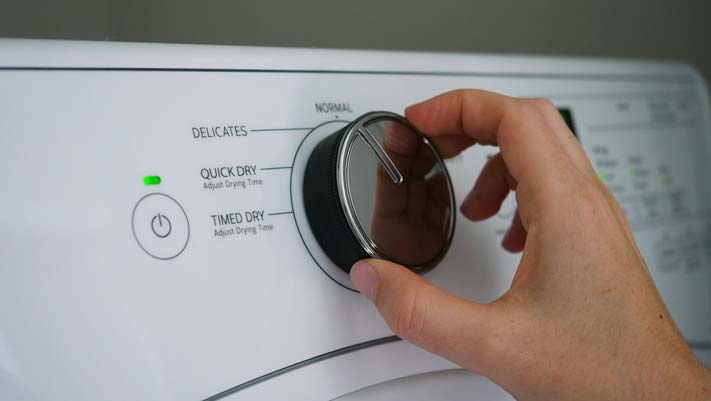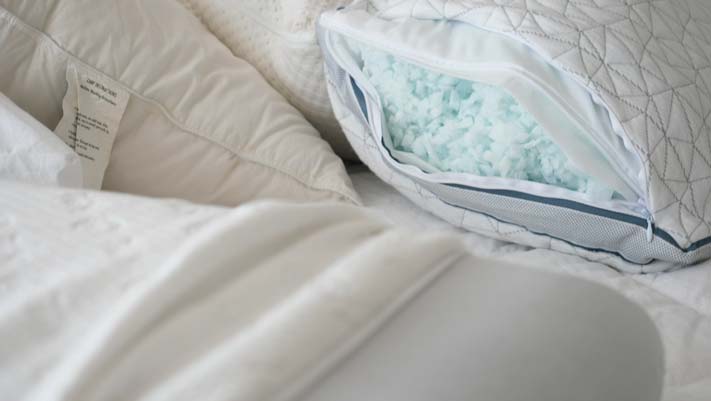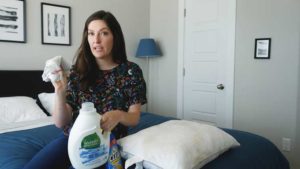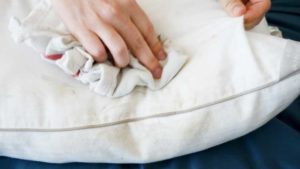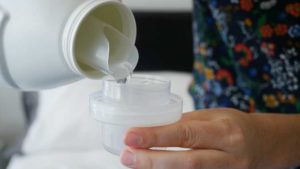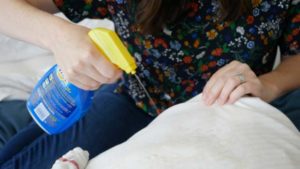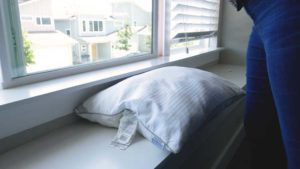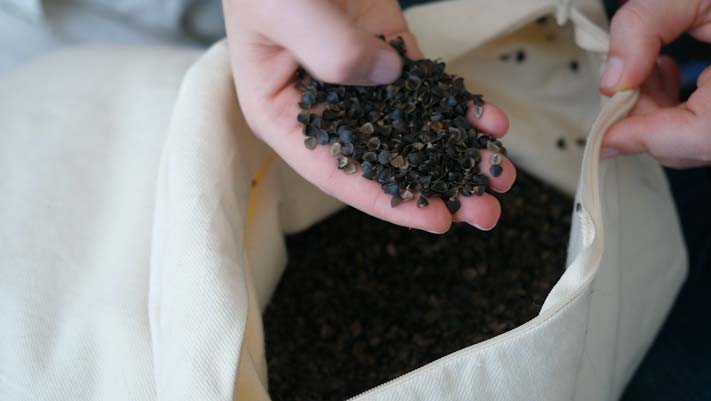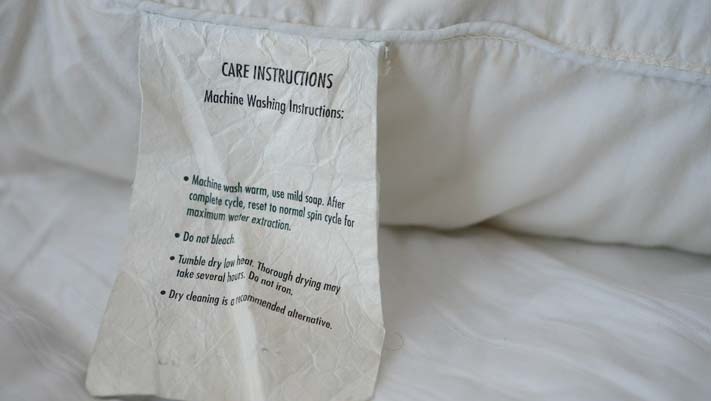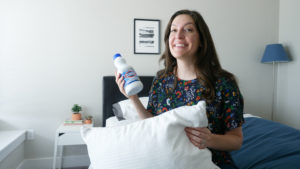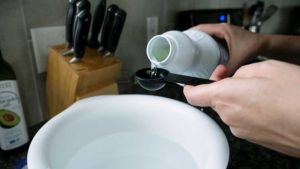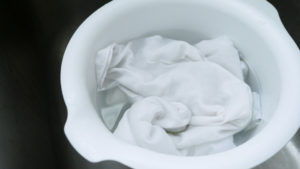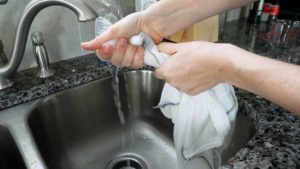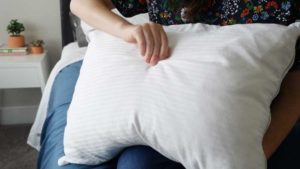Have you ever stopped to think about how long it has been since you cleaned your pillow? Have you ever cleaned your pillow?
If you’re reading this post and watching our video, chances are it’s been a while. Fear not, we’ve got you covered.
Jump To
How Often Should You Wash Your Pillow? | How to Wash Your Pillow in a Washing Machine | How to Spot-Clean Your Pillow | Pillows You Cannot Wash | How to Use Bleach to Remove Tough Stains
Whether or not you use a pillowcase, having a clean pillow is important. Dead skin cells, facial oils, drool, sweat, and other gross stuff can be absorbed through your pillowcase and end up in your pillow over time.
That adds weight to your pillow and makes it a den for bacteria, dust mites, and other unhealthy microbes that can worsen your allergies or make you sick. It also stops your pillow from being able to perform at its highest level and provide you with the support you need.
So, how do I clean my pillow? There is no one-size-fits-all answer to this question. It will depend a lot on what materials are used to make your pillow. In some cases, you’ll be able to remove and wash just the cover; in other cases, you can wash the whole pillow (filling and cover). Don’t worry, we’ve broken it all down below.
If you have any specific questions, don’t hesitate to comment and we’ll do our best to help you figure out how to clean your pillow as well!
How Often Should I Wash My Pillow?
If you get your pillow dirty, wash it right away. If nothing especially gross happens to it, try to wash it at least every 4 to 6 months. I like to wash my pillows once a quarter (so approximately once every three months) when I rotate my mattress.
It’s always a good idea to air out or fluff your pillow occasionally, as well. That might mean throwing it in the dryer for a few minutes to help it maintain its loft or leaving it outside in the fresh air overnight.
Check out our list of Best Pillows for 2023.
Washing Your Pillow in the Washing Machine
Basic Instructions
Great news: Many types of pillows and pillow fillings are washing machine-friendly. This includes most down or down alternative options and even some foam pillows. We’ve broken down the instructions for different fillings a little further down; however, if you just want the basics, check out our step-by-step guide below:
Pour Delicate Detergent into the Washer
Add a mild detergent to your washing machine. If you’re washing the pillow by itself, use only a small amount of detergent. If you’re using a top-loading washer, consider adding something else into the load to balance it and avoid potentially damaging your pillow.
Turn the Washer on a Gentle Cycle
If your pillow has a removable cover, unzip it and take it off before washing to help both the cover and filling get as clean as possible.
More likely than not, the care instructions on your pillow will say to do a gentle wash and dry, so use a delicate washer setting whenever possible.
The water temperature should be either cool or warm.
Use “Drain & Spin” Cycle
Once the gentle cycle is complete, put the pillow on a “drain and spin” cycle. This will help pull water out of the pillow after it’s been cleaned. The more moisture you can get out of your pillow in the washer, the faster it will dry when you transfer it to the dryer.
Dry the Pillow
When the pillow cover and filling are ready to go into the dryer, place a tennis ball in a tube sock and add this to the dryer along with the pillow.
The tennis ball in the tube sock will bounce around inside the dryer and gently push on the pillow, breaking up any filling and helping it to dry as efficiently as possible.
Set the heat on a lower heat setting so you don’t potentially burn the pillow.
Depending on the filling material, it may take several cycles to get your pillow fully dry.
Cleaning Different Types of Pillows
Polyester
Most down alternative or microfiber filling pillows are made of polyester. This is one of the easier materials to clean, so congratulations! More likely than not, you can put your pillow in the washing machine (make sure to keep the load balanced) and put it on a cool or warm delicate wash. Once it’s clean, toss it into the dryer on a low tumble dry.
Pro Tip: Adding one or two tennis balls housed in socks (so the green dye doesn’t transfer) will help break up the filling in your pillow and allow it to dry faster.
Down/Feather
Down pillows (in general) can be machine washed and dried just like their down alternative counterparts. The key is to be gentle with it; this means using detergents that aren’t harsh (no bleach!) and washing on a delicate cycle and air drying or doing a low tumble dry.
If your pillow smells funky after you pull it out of the dryer, that means it’s not fully dry yet. Try hand fluffing it before throwing it back in, and don’t be alarmed if it takes a few cycles.
Shredded Foam
The best way to clean your foam pillow will vary depending on whether it’s a solid piece of foam or shredded pieces. Shredded foam pillows can often be washed in the washing machine (in most cases). You’ll want to wring out the foam pieces before throwing the pillow in the dryer to help lower the drying time, and make sure to add the tennis balls in socks that I mentioned earlier. It can take many cycles in the dryer for a shredded foam pillow to dry completely.
Microbeads
Microbeads can be machine washed in most cases, but they require an extra step. You will want to wrap the pillow in a large pillowcase and tie it up so the beads don’t accidentally spill out in your laundry machine.
How to Spot-Clean Your Pillow
Basic Instructions
Typically, it’s not advisable for you to do anything but spot-clean a pillow that features a solid piece of foam, including memory foam and latex pillows. Check out our step-by-step guide below on how to spot-clean a pillow.
Grab Your Supplies
The three main things you’ll need when spot-cleaning your pillow are a clean cloth, mild detergent, and some water.
If you have some particularly bad stains, you may need a stain remover as well.
Wet the Area with a Damp Cloth
Take your damp cloth and gently rub the dirty area of your pillow. This should loosen up some of the dirt and get it ready for the detergent.
Add Mild Detergent to the Cloth
Dip your cloth into a small amount of mild detergent and use the cloth to gently rub the dirty area and clean it as best as possible.
Use Your Stain Remover
If you aren’t seeing any changes to your pillow, consider adding a little bit of stain remover and leave it to do its magic before coming back with a damp cloth.
Remove the Excess Detergent
Take another section of dampened cloth and rub the cleaned area again to remove any excess detergent or stain remover.
Let the Pillow Air Dry
Once the pillow has been spot-cleaned by hand, place it by an open window or a well-ventilated area where it can dry fully. Be sure to avoid putting your memory foam or latex pillow in the dryer, as this could potentially melt the foam.
Pillows That Should Not be Washed
There are some fillings that are special and cannot be washed. But don’t worry; in many cases, you can remove the filling and still wash the outer cover to keep it somewhat clean.
- Buckwheat hulls. Don’t wash the buckwheat hulls in a buckwheat pillow; instead, just wash the cover. If the hulls become damp or soggy, they won’t work as a filling. You can put the hulls in a plastic bag while you wash and dry the cover. It will make a mess, but it’s worth it for a clean pillow.
- Kapok fibers. These eco-friendly fibers, which are the seed pod fluff from a rainforest tree, cannot be cleaned. Pillows with Kapok fibers are often spot-cleaned only or have removable covers that can be cleaned separately.
How to Use Bleach to Remove Tough Stains
Grab Your Bleach
You can give your pillowcase a quick bleach soak using a bucket or tub, a measuring spoon, water, and (obviously) some bleach.
Add Bleach to a Bucket of Cool Water
You’ll want to use 1/4 of a cup of Clorox® (or bleach of your choice) and one gallon of cool water.
Soak Your Pillowcase for 5 – 10 Minutes
Let the pillowcase soak submerged in the bucket for around 10 minutes.
Squeeze Out Water
Once the soak is done, rinse the pillowcase out with cool water from the sink. Then squeeze or ring out the pillowcase so it’s as dry as possible and then throw it in the dryer to finish it off.
Enjoy Your Sparkling Clean Pillow
It’s clean!
Overall
Because there’s so much variation among pillows, the best way to be sure that you’re cleaning your pillow correctly is to read the care tag on your own pillow. If you no longer have the tag, go online and look up the pillow via its website; most companies post their care instructions online. These are going to be the best guide to cleaning your pillow.
But if you’ve lost your tag or don’t feel like going on a scavenger hunt, then follow the basic instructions above and either use the washing machine or spot-clean it. Keeping your pillow clean is essential to good sleep health (and just a good health practice in general!).
Don’t forget to read about how to clean mattress stains. If you’re already in cleaning mode, you can go ahead and work on your mattress as well!
RELATED: How to Wash a Comforter
One final note: If you really, really can’t remember how long it’s been since you’ve cleaned your pillow and it looks really yellow or feels damp and/or unnaturally heavy, it’s time to trash it and get a new one.
Different pillows work better for different sleep types, so if you’re in the market for a new pillow, make sure to check out my list of best pillows.
